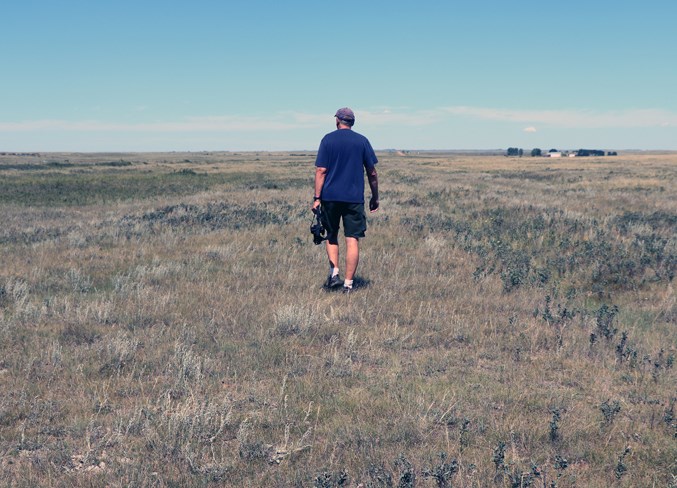CAROLSIDE-ALDERSON - Under a scorching hot sun heritage journalist Chris Doering braved a day that was physically exhausting but exhilarating nevertheless.
By the early evening of July 26 the shadows became longer and longer but the sun's heat had barely diminished, nor had his shock from experiencing the sight of the final decaying remnants of two once promising pioneer communities that held the unbridled hopes and dreams of countless early 20th century settlers.
The 54-year-old writer and his wife Connie Biggart left their home in Calgary early in the morning to meet a fellow scribbler in the Drumheller ghost town of Dorothy. From there the trio headed east to the God-forsaken environs of the Peavine Line where a half dozen ghost towns, from Sheerness in the north to Steveville, 77 kilometres away in the south, briefly tasted prosperity. Most boasted robust business districts, and of course prized country grain elevators, a prestigious symbol of early pioneer prairie living. Today, however, all grain elevators are gone, along with every pioneer hope and dream. It's a struggle to count even a dozen humans left in this vast sun scorched flatland expanse.
Right smack in the middle of this sad desolation is Carolside, a municipality established in 1919 when the Canadian National Railway came through from Hanna. Century-old blueprints for the new town still exist, and show a planned 24-metre-wide Main Street running at right angles to the railway, as well as a 20-metre-wide Railways Avenue.
"This will be a great convenience as this street passes right through the business section of Carolside," said the Hanna Herald in an unabashedly cheery article on Feb. 19, 1920 about the new town's promised prosperity. The article went on to list all the planned ventures that included grocery and hardware stores, a real estate business, a feed mill and even a manufacturing plant - all to be opened to great fanfare for the coming May Day celebration.
It would not be. Carolside managed to hang on but only barely against the increasingly harsh reality of the land's decaying overheated earth, North American stock market crashes and the Great Depression. By the early 1960s it was all over. Carolside was left to the ghosts.
Six years ago Doering and Biggart, who operate their heritage journalism blog site, Off The Beaten Path with Chris & Connie, first visited the barren Carolside townsite. The grain elevator was long gone, as was every single other structure. Only a scattering of depressions where a house or business once stood remained, along with a few piles of lumber and waste.
On July 26 they came back. This time they were able to find the cement foundation where an elevator once stood, and the site of a small train station that probably also served for storage and maintenance use. It was an exhilarating find, real proof a community once thrived at this God-forsaken spot. Even still, Doering had to concede that Carolside gave every appearance of being one of the "saddest places on earth.
"How there ever was a town here is beyond me," he remarked while gazing at the flat emptiness all around him.
That emptiness around Carolside stretched a full 125 kilometres south to a place even more God-forsaken than Carolside. They drove all the way to Brooks, and headed east on the Trans-Canada Highway until turning off onto a gravel road to find Alderson, nicknamed Star of the Prairie on the promise by early 20th century speculators it would be the centre of newfound prosperity for settlers. Instead, as detailed brilliantly in David C. Jones' book Empire of the Dust, Alderson became the centre of one of Canada's worst agriculture disasters; a ghost town by the 1940s. Today it's almost impossible to find Alderson. Its last two dilapidated weather-beaten structures, a CPR section house and Al Cole's collapsing livery, burned to the ground during a prairie fire in 2014. From the Old Trans-Canada Highway that runs just north of the townsite and CPR tracks, visitors will only see an empty field.
However, a closer inspection reveals Alderson's tragic secrets. There are a score of cement foundations where its once hopeful business district once stood, including a massive one for the Woollven store, the town's last remaining major structure that fell victim to arsonists in the late 1970s. Visitors will find an assortment of other ancient relics, including an old car in a foundation, another with a 100-year-old wood stove, and countless cans and bottles, even bits of bricks at the site of the old Union Bank. Mostly though, there is only an overwhelming sense of despair coming from this haunting place of shadows and ghosts.
"This really is the saddest place on earth. Even standing at the edge of Alderson you would be hard pressed to know there was anything there. What strikes me as a similarity with them is that they're towns that in a blink of an eye were here and gone. They existed for a very short period of time and if one does not take the time to look closely you would never know they were there.
"I can't help but think about the people that arrived and holding such promise and how quickly these dreams were dashed. These places only boomed for a short period before everybody realized that they were probably not going to amount to much and not going to last long," he said. "I try to put myself in the mindset of those people and try to convince myself it's going to be good, or the sheer sadness of knowing it's not going to end well.
"I find that rather haunting," added Doering. "It's just a blip in history; a very interesting blip if you were to research its history. It's just nothingness now."



